

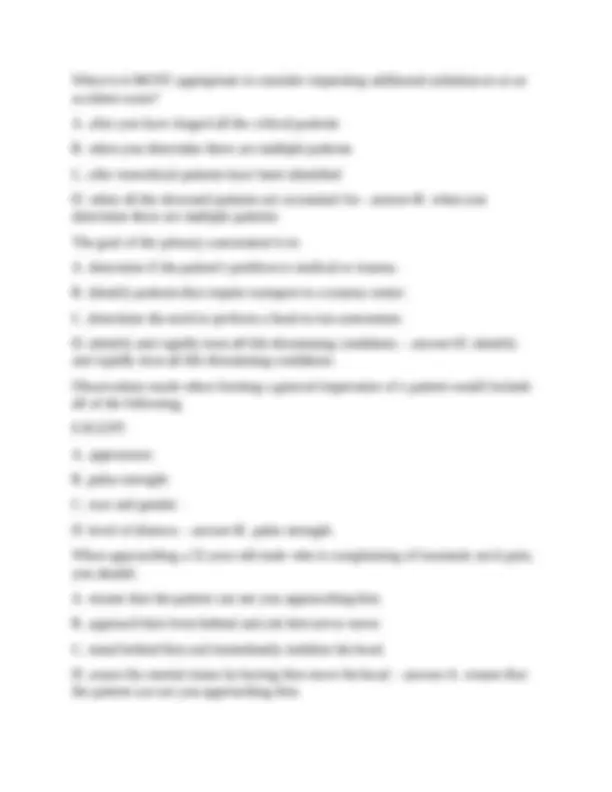
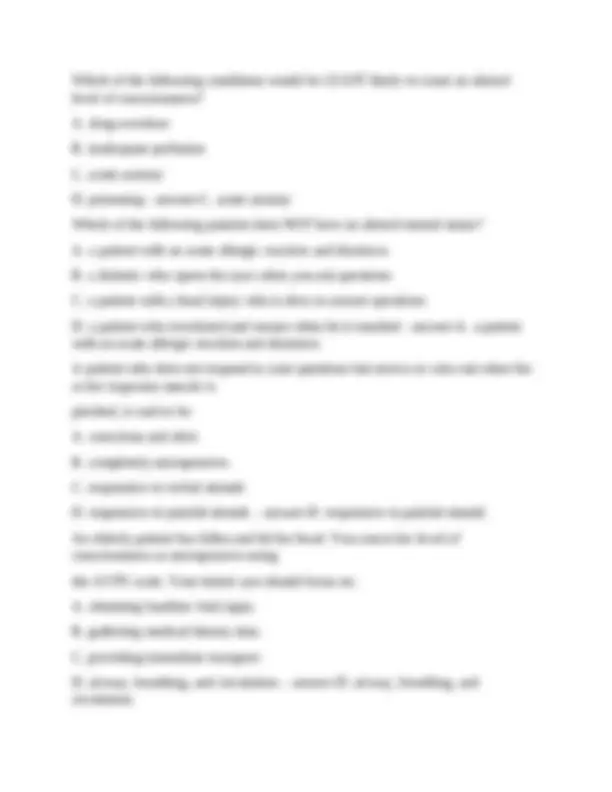
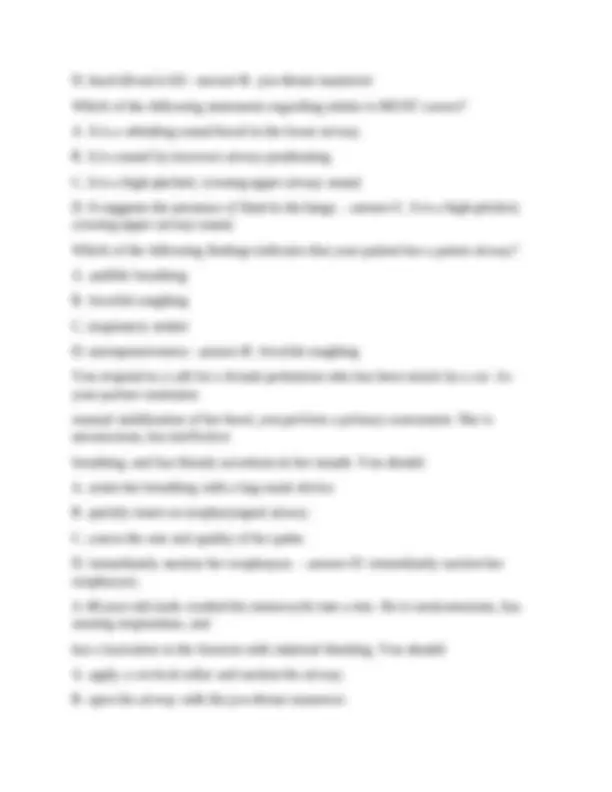
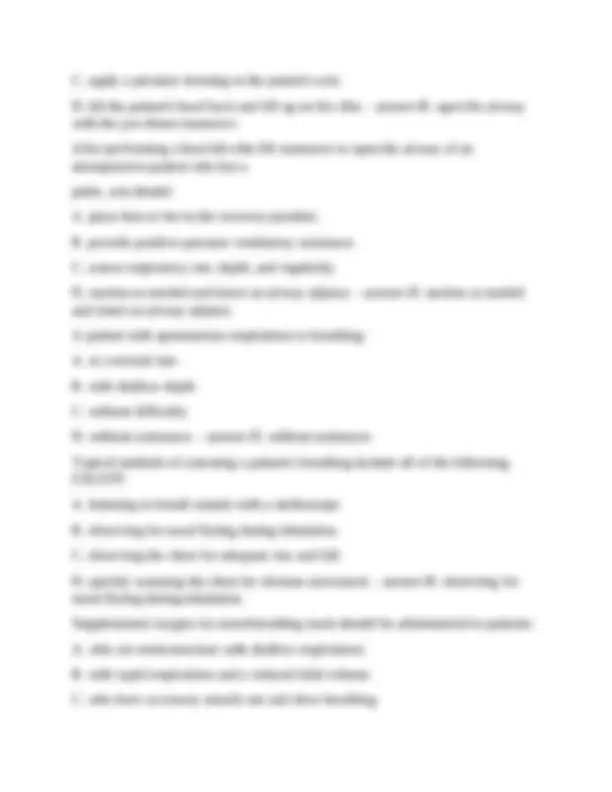
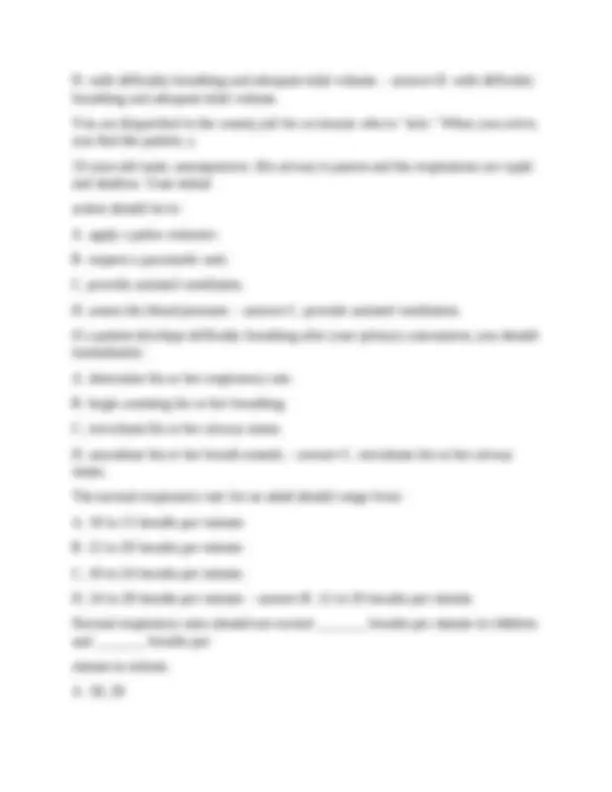
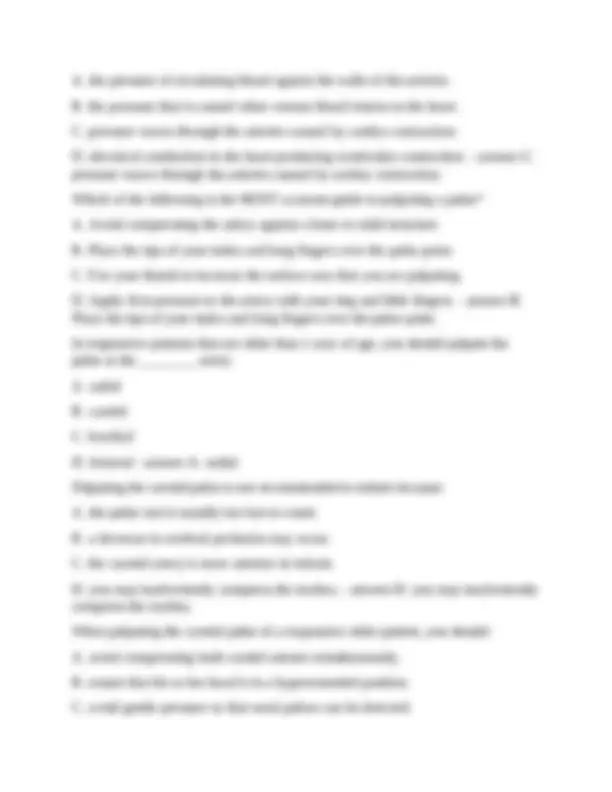
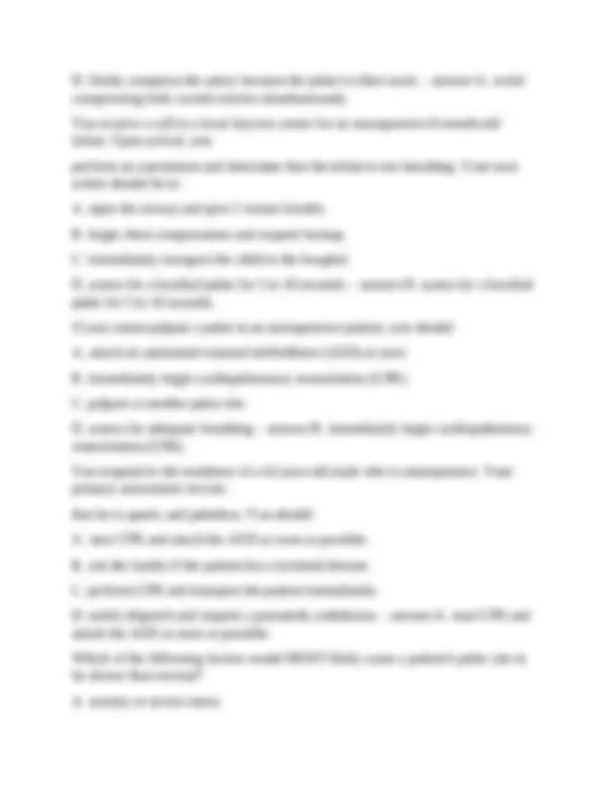
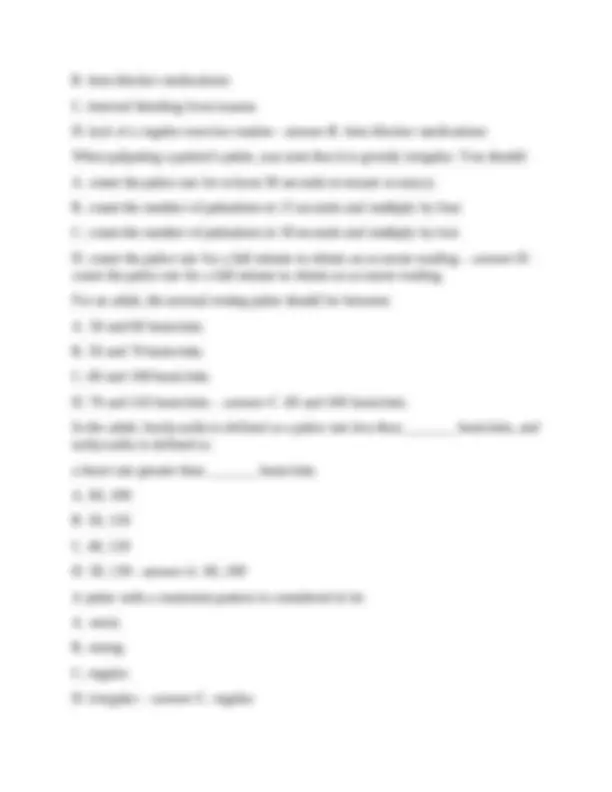
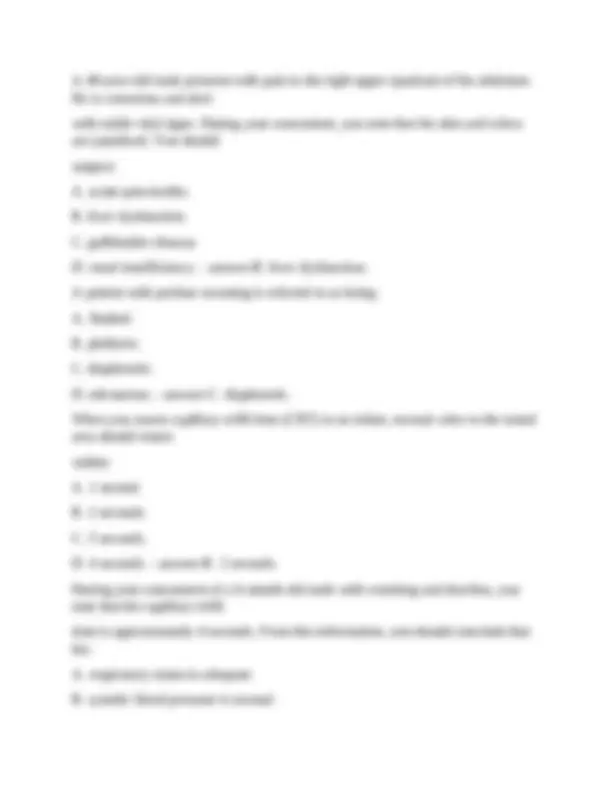
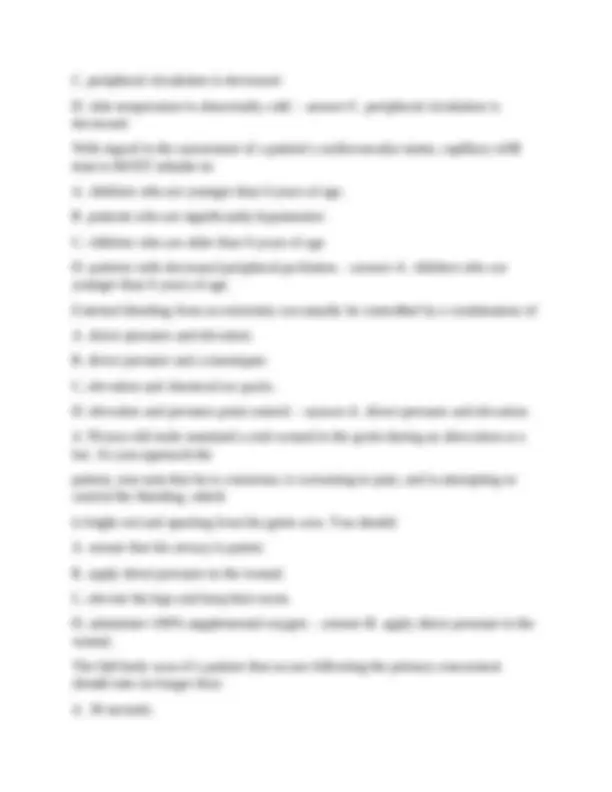
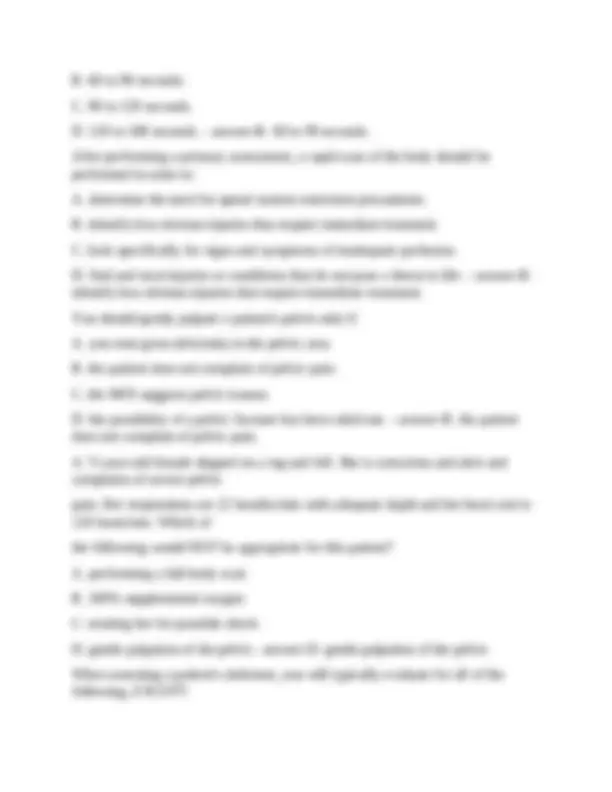
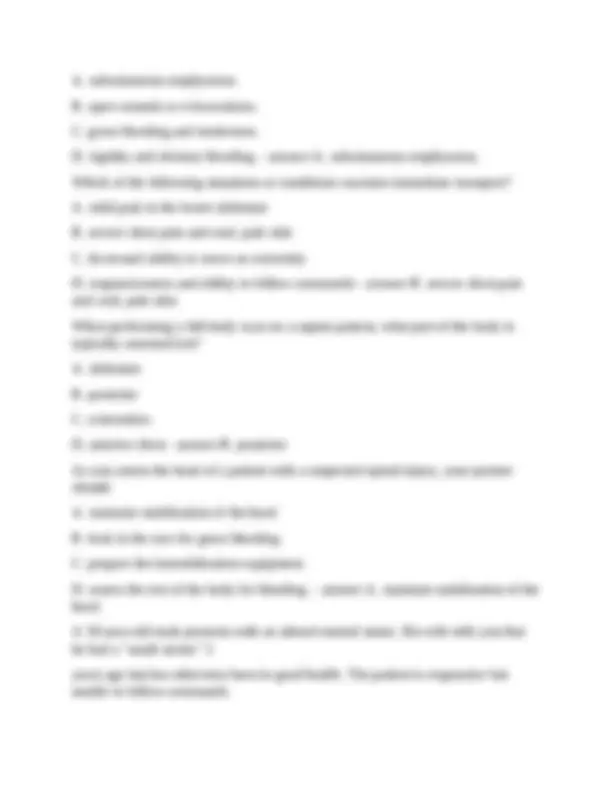

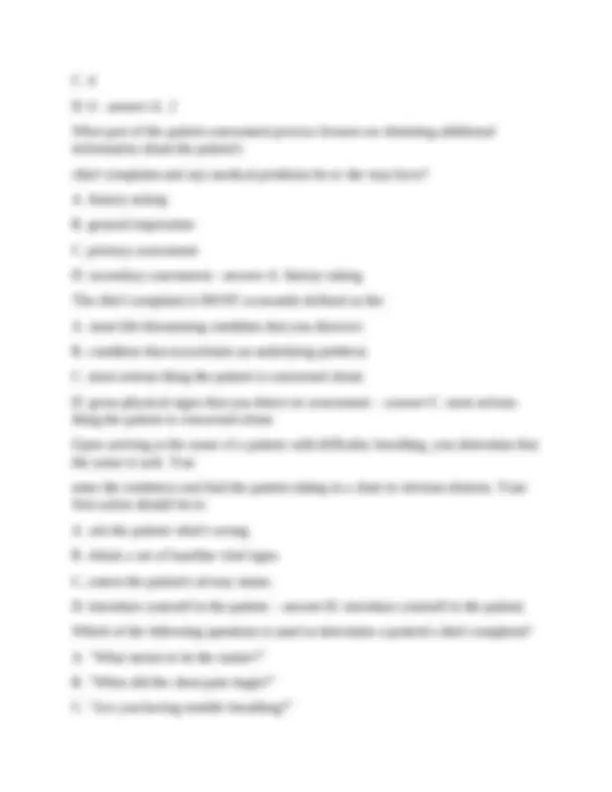
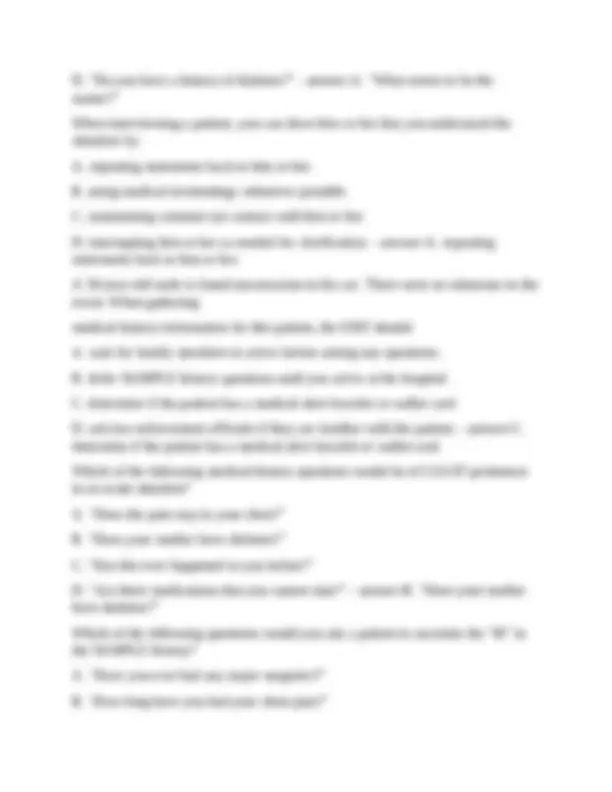
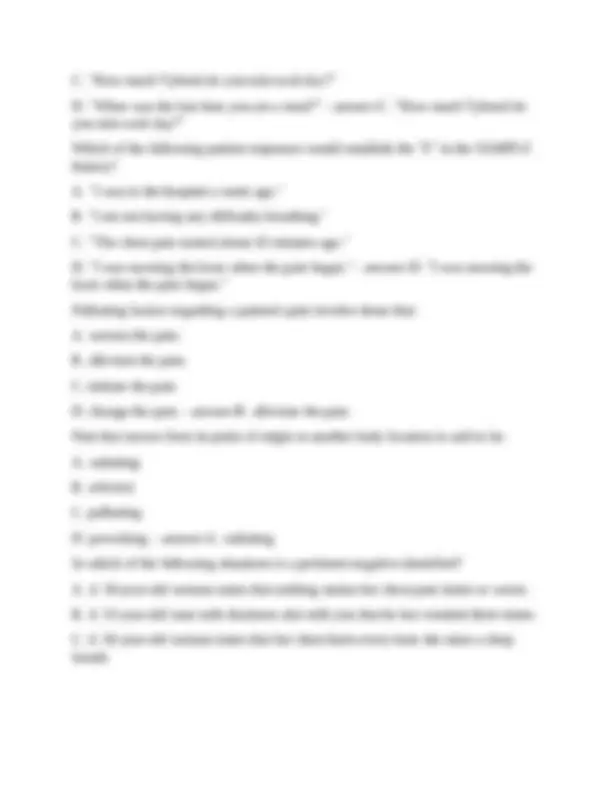
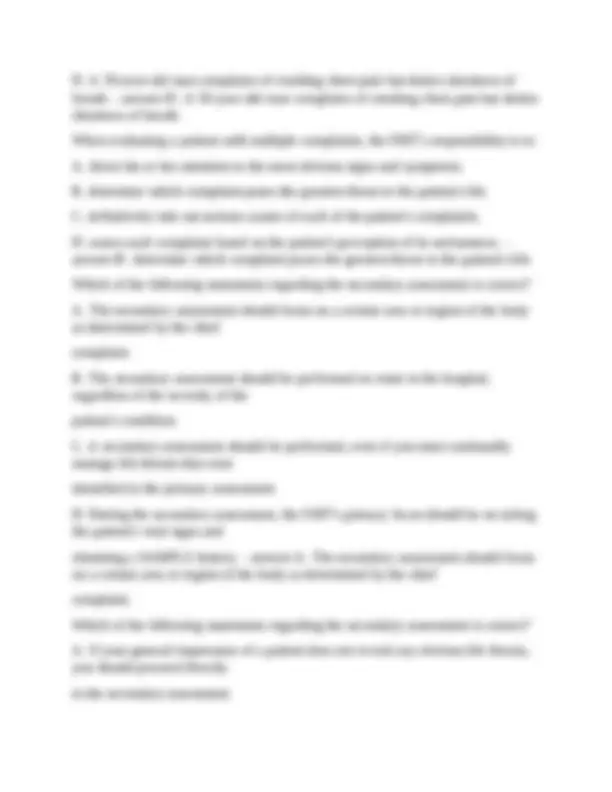
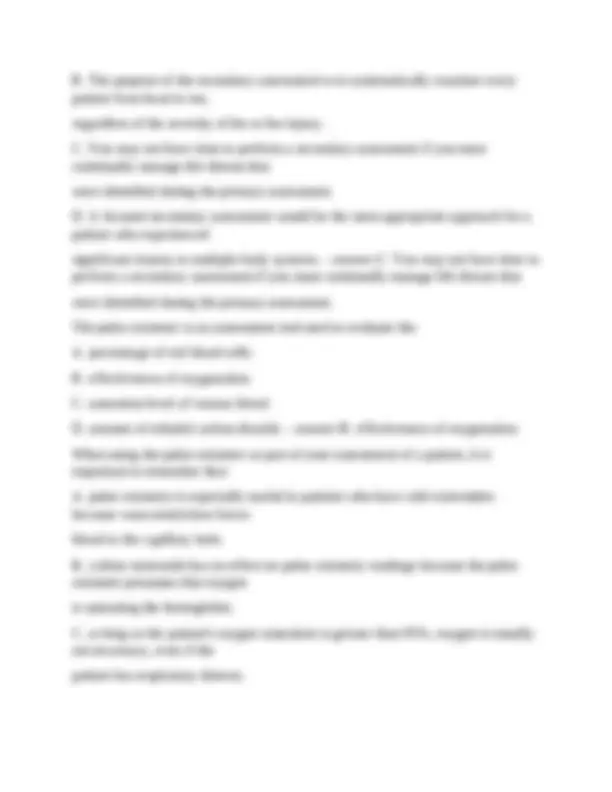
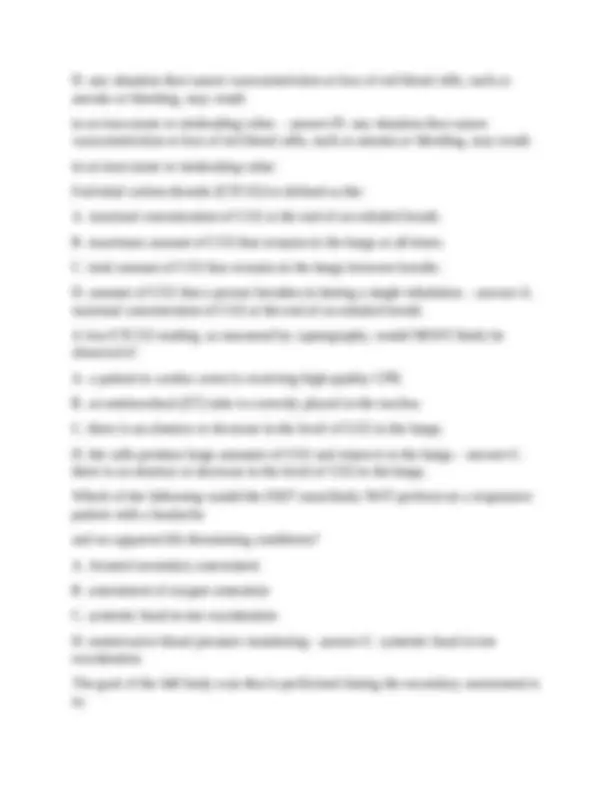
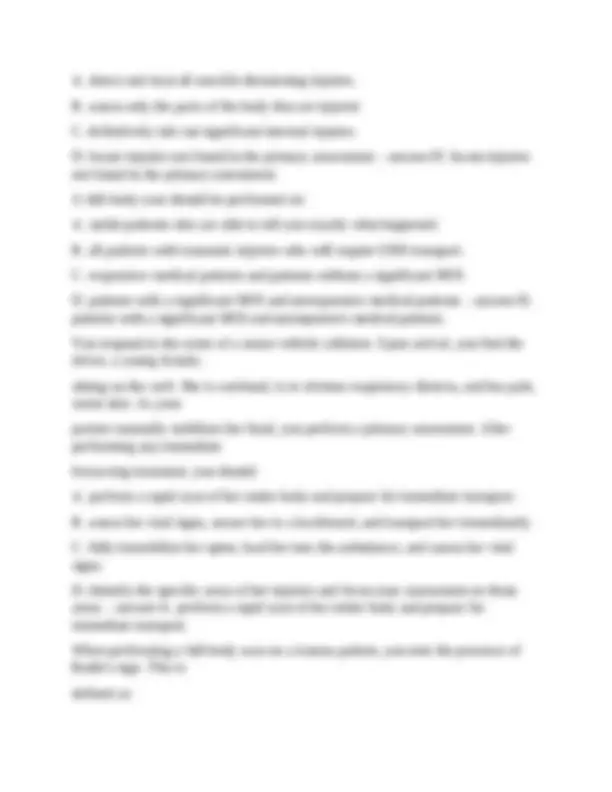
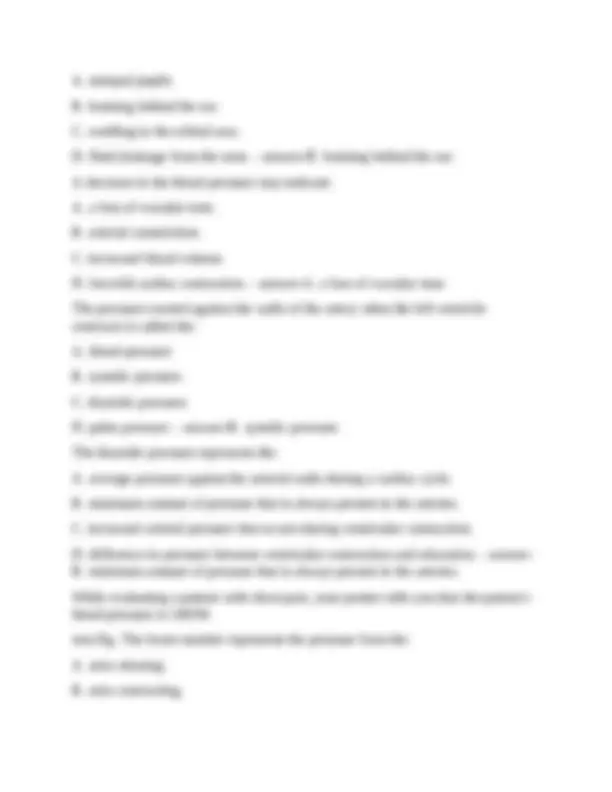

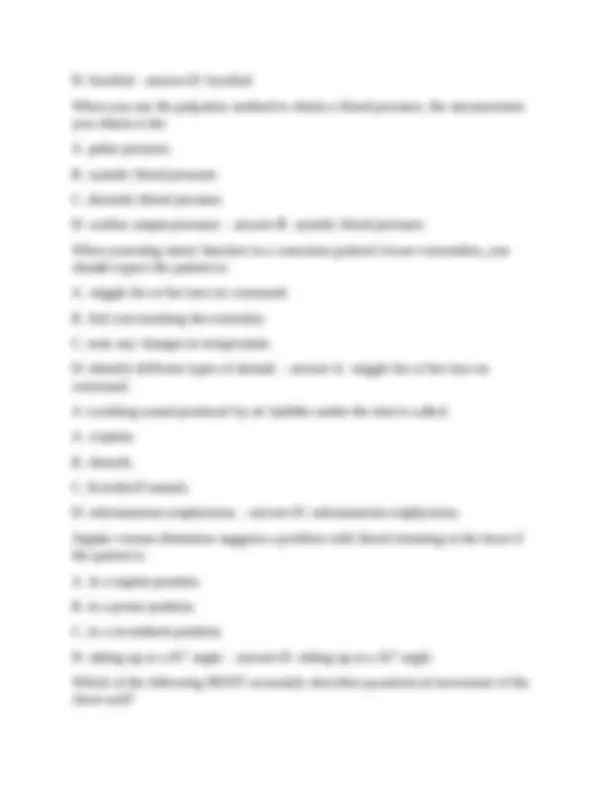
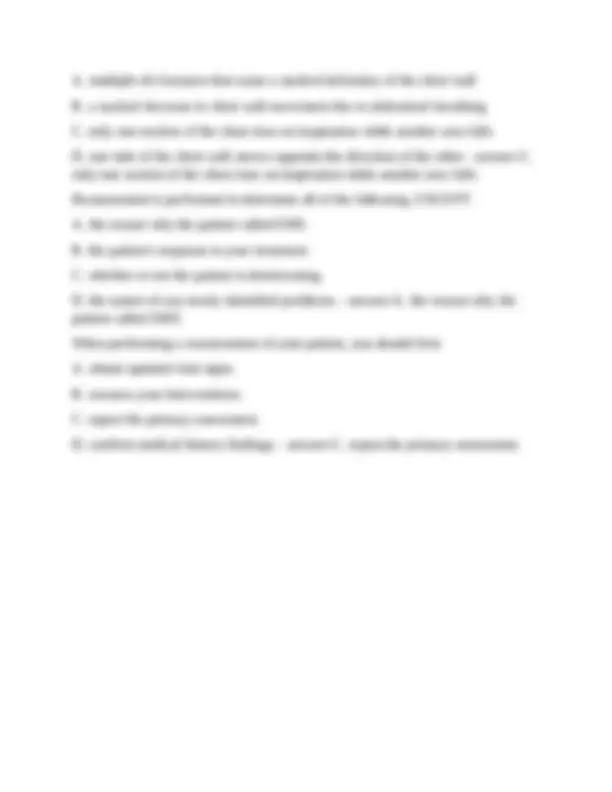


Study with the several resources on Docsity

Earn points by helping other students or get them with a premium plan


Prepare for your exams
Study with the several resources on Docsity

Earn points to download
Earn points by helping other students or get them with a premium plan
Community
Ask the community for help and clear up your study doubts
Discover the best universities in your country according to Docsity users
Free resources
Download our free guides on studying techniques, anxiety management strategies, and thesis advice from Docsity tutors
A series of multiple-choice questions related to patient assessment in the context of emergency medical technician (emt) training. It covers topics such as scene size-up, mechanism of injury, primary assessment, level of consciousness, airway management, and pupillary response. The questions are designed to test the reader's understanding of key concepts and procedures involved in patient assessment.
Typology: Exams
1 / 33

This page cannot be seen from the preview
Don't miss anything!


























Which of the following is an example of a symptom? A. cyanosis B. headache C. tachycardia D. hypertension - answer-B. headache Which of the following scenarios does NOT involve the presence of any symptoms? A. a 44-year-old male with abdominal pain and severe dizziness B. a 49-year-old female with blurred vision and ringing in the ears C. a 55-year-old male with a severe headache and 2 days of nausea D. a 61-year-old female who is unconscious with facial cyanosis - answer-D. a 61- year-old female who is unconscious with facial cyanosis Which of the following actions would NOT be performed during the scene size- up? A. asking a neighbor to secure the patient's dog B. rapidly assessing a patient's respiratory status C. notifying the dispatcher to send fire personnel D. noting the position of a crashed motor vehicle - answer-B. rapidly assessing a patient's respiratory status While en route to the scene of a shooting, the dispatcher advises you that the caller states that the perpetrator has fled the scene. You should: A. ask the dispatcher if he or she knows the location of the perpetrator. B. confirm this information with law enforcement personnel at the scene.
C. request law enforcement personnel if the scene is unsafe upon arrival. D. proceed to the scene as usual but exercise extreme caution upon arrival. - answer-B. confirm this information with law enforcement personnel at the scene. Upon arriving at a potentially unsafe scene, you should: A. remove all bystanders. B. request another ambulance. C. move the patient to safety. D. ensure that you are safe. - answer-D. ensure that you are safe. You are assessing a 72-year-old man with abdominal pain. The patient is sitting in a chair; he is conscious, alert, and calm. As you are talking to the patient, your partner discreetly directs your attention to a handgun, which is located on a nearby table. You should: A. immediately cease all patient care, carefully back out of the residence, and request law enforcement assistance. B. direct your partner to move the gun to a safe area and then advise the patient that his weapon has been secured. C. document the presence of the weapon, including its specific location, and continue your assessment of the patient. D. position yourself in between the patient and the gun and ask your partner to request law enforcement assistance. - answer-D. position yourself in between the patient and the gun and ask your partner to request law enforcement assistance.
When is it MOST appropriate to consider requesting additional ambulances at an accident scene? A. after you have triaged all the critical patients B. when you determine there are multiple patients C. after noncritical patients have been identified D. when all the deceased patients are accounted for - answer-B. when you determine there are multiple patients The goal of the primary assessment is to: A. determine if the patient's problem is medical or trauma. B. identify patients that require transport to a trauma center. C. determine the need to perform a head-to-toe assessment. D. identify and rapidly treat all life-threatening conditions. - answer-D. identify and rapidly treat all life-threatening conditions. Observations made when forming a general impression of a patient would include all of the following, EXCEPT: A. appearance. B. pulse strength. C. race and gender. D. level of distress. - answer-B. pulse strength. When approaching a 32-year-old male who is complaining of traumatic neck pain, you should: A. ensure that the patient can see you approaching him. B. approach him from behind and ask him not to move. C. stand behind him and immediately stabilize his head. D. assess his mental status by having him move his head. - answer-A. ensure that the patient can see you approaching him.
Which of the following conditions would be LEAST likely to cause an altered level of consciousness? A. drug overdose B. inadequate perfusion C. acute anxiety D. poisoning - answer-C. acute anxiety Which of the following patients does NOT have an altered mental status? A. a patient with an acute allergic reaction and dizziness B. a diabetic who opens his eyes when you ask questions C. a patient with a head injury who is slow to answer questions D. a patient who overdosed and moans when he is touched - answer-A. a patient with an acute allergic reaction and dizziness A patient who does not respond to your questions but moves or cries out when his or her trapezius muscle is pinched, is said to be: A. conscious and alert. B. completely unresponsive. C. responsive to verbal stimuli. D. responsive to painful stimuli. - answer-D. responsive to painful stimuli. An elderly patient has fallen and hit her head. You assess her level of consciousness as unresponsive using the AVPU scale. Your initial care should focus on: A. obtaining baseline vital signs. B. gathering medical history data. C. providing immediate transport. D. airway, breathing, and circulation. - answer-D. airway, breathing, and circulation.
A. constricting. B. enlarging. C. dilating. D. fluttering. - answer-A. constricting. When you shine a light into one pupil, the normal reaction of the other pupil should be to: A. dilate. B. not react. C. become larger. D. become smaller. - answer-D. become smaller. Which of the following pupillary changes would indicate depressed brain function? A. Both pupils dilate when a bright light is removed. B. Both pupils constrict when a bright light is introduced. C. Both pupils react briskly to light instead of sluggishly. D. Both pupils dilate with introduction of a bright light. - answer-D. Both pupils dilate with introduction of a bright light. Which of the following conditions would MOST likely cause the pupils to remain significantly constricted? A. severe cerebral hypoxia B. intracranial hemorrhaging C. overdose of an opiate drug D. oculomotor nerve pressure - answer-C. overdose of an opiate drug What maneuver should be used to open the airway of an unresponsive patient with suspected trauma? A. tongue-jaw lift B. jaw-thrust maneuver C. head tilt-chin lift
D. head tilt-neck lift - answer-B. jaw-thrust maneuver Which of the following statements regarding stridor is MOST correct? A. It is a whistling sound heard in the lower airway. B. It is caused by incorrect airway positioning. C. It is a high-pitched, crowing upper airway sound. D. It suggests the presence of fluid in the lungs. - answer-C. It is a high-pitched, crowing upper airway sound. Which of the following findings indicates that your patient has a patent airway? A. audible breathing B. forceful coughing C. inspiratory stridor D. unresponsiveness - answer-B. forceful coughing You respond to a call for a female pedestrian who has been struck by a car. As your partner maintains manual stabilization of her head, you perform a primary assessment. She is unconscious, has ineffective breathing, and has bloody secretions in her mouth. You should: A. assist her breathing with a bag-mask device. B. quickly insert an oropharyngeal airway. C. assess the rate and quality of her pulse. D. immediately suction her oropharynx. - answer-D. immediately suction her oropharynx. A 40-year-old male crashed his motorcycle into a tree. He is semiconscious, has snoring respirations, and has a laceration to the forearm with minimal bleeding. You should: A. apply a cervical collar and suction his airway. B. open his airway with the jaw-thrust maneuver.
D. with difficulty breathing and adequate tidal volume. - answer-D. with difficulty breathing and adequate tidal volume. You are dispatched to the county jail for an inmate who is "sick." When you arrive, you find the patient, a 33-year-old male, unresponsive. His airway is patent and his respirations are rapid and shallow. Your initial action should be to: A. apply a pulse oximeter. B. request a paramedic unit. C. provide assisted ventilation. D. assess his blood pressure. - answer-C. provide assisted ventilation. If a patient develops difficulty breathing after your primary assessment, you should immediately: A. determine his or her respiratory rate. B. begin assisting his or her breathing. C. reevaluate his or her airway status. D. auscultate his or her breath sounds. - answer-C. reevaluate his or her airway status. The normal respiratory rate for an adult should range from: A. 10 to 15 breaths per minute. B. 12 to 20 breaths per minute. C. 18 to 24 breaths per minute. D. 24 to 28 breaths per minute. - answer-B. 12 to 20 breaths per minute. Normal respiratory rates should not exceed _______ breaths per minute in children and _______ breaths per minute in infants. A. 18, 28
D. 30, 50 - answer-D. 30, 50 Which of the following is the MOST effective method of assessing the quality of air movement in the lungs? A. evaluating the patient's chest for cyanosis B. applying a pulse oximeter and monitoring the SpO C. auscultating breath sounds with a stethoscope D. looking for the presence of accessory muscle use - answer-C. auscultating breath sounds with a stethoscope Which of the following abnormal breath sounds indicates obstruction of the upper airway? A. rales B. stridor C. crackles D. rhonchi - answer-B. stridor Clinical signs of labored breathing include all of the following, EXCEPT: A. shallow chest movement. B. use of accessory muscles. C. supraclavicular retractions. D. gasping attempts to breathe. - answer-A. shallow chest movement. When a patient's respirations are shallow: A. chest rise will be easily noticeable. B. tidal volume is markedly reduced. C. oxygenation occurs more efficiently.
A. the pressure of circulating blood against the walls of the arteries. B. the pressure that is caused when venous blood returns to the heart. C. pressure waves through the arteries caused by cardiac contraction. D. electrical conduction in the heart producing ventricular contraction. - answer-C. pressure waves through the arteries caused by cardiac contraction. Which of the following is the MOST accurate guide to palpating a pulse? A. Avoid compressing the artery against a bone or solid structure. B. Place the tips of your index and long fingers over the pulse point. C. Use your thumb to increase the surface area that you are palpating. D. Apply firm pressure to the artery with your ring and little fingers. - answer-B. Place the tips of your index and long fingers over the pulse point. In responsive patients that are older than 1 year of age, you should palpate the pulse at the ________ artery. A. radial B. carotid C. brachial D. femoral - answer-A. radial Palpating the carotid pulse is not recommended in infants because: A. the pulse rate is usually too fast to count. B. a decrease in cerebral perfusion may occur. C. the carotid artery is more anterior in infants. D. you may inadvertently compress the trachea. - answer-D. you may inadvertently compress the trachea. When palpating the carotid pulse of a responsive older patient, you should: A. avoid compressing both carotid arteries simultaneously. B. ensure that his or her head is in a hyperextended position. C. avoid gentle pressure so that weak pulses can be detected.
D. firmly compress the artery because the pulse is often weak. - answer-A. avoid compressing both carotid arteries simultaneously. You receive a call to a local daycare center for an unresponsive 8-month-old infant. Upon arrival, you perform an assessment and determine that the infant is not breathing. Your next action should be to: A. open the airway and give 2 rescue breaths. B. begin chest compressions and request backup. C. immediately transport the child to the hospital. D. assess for a brachial pulse for 5 to 10 seconds. - answer-D. assess for a brachial pulse for 5 to 10 seconds. If you cannot palpate a pulse in an unresponsive patient, you should: A. attach an automated external defibrillator (AED) at once. B. immediately begin cardiopulmonary resuscitation (CPR). C. palpate at another pulse site. D. assess for adequate breathing. - answer-B. immediately begin cardiopulmonary resuscitation (CPR). You respond to the residence of a 62-year-old male who is unresponsive. Your primary assessment reveals that he is apneic and pulseless. You should: A. start CPR and attach the AED as soon as possible. B. ask the family if the patient has a terminal disease. C. perform CPR and transport the patient immediately. D. notify dispatch and request a paramedic ambulance. - answer-A. start CPR and attach the AED as soon as possible. Which of the following factors would MOST likely cause a patient's pulse rate to be slower than normal? A. anxiety or severe stress
When palpating a patient's pulse, you note that there is a short interval between pulsations. This indicates that the pulse is: A. slow. B. rapid. C. irregular. D. thready. - answer-B. rapid. When assessing a 62-year-old female with crushing chest pain, you note that her pulse is rapid and irregular. In addition to administering oxygen, you should: A. apply a cardiac monitor and observe her cardiac rhythm. B. transport at once and consider requesting a paramedic unit. C. document your findings and perform a detailed assessment. D. conclude that the irregular pulse is normal based on her age. - answer-B. transport at once and consider requesting a paramedic unit. In patients with deeply pigmented skin, changes in color may be apparent only in certain areas, such as the: A. back of the neck. B. forehead and face. C. dorsum of the hand. D. lips or oral mucosa. - answer-D. lips or oral mucosa. In infants and small children, skin color should be assessed on the: A. forehead. B. palms and soles. C. chest and abdomen. D. underside of the arms. - answer-B. palms and soles. Poor peripheral circulation will cause the skin to appear:
A. pink. B. ashen. C. flushed. D. cyanotic. - answer-B. ashen. When assessing the skin of an unconscious patient, you note that it has a bluish tint to it. This finding is called: A. pallor. B. flushing. C. cyanosis. D. mottling. - answer-C. cyanosis. Cyanosis of the skin is caused by: A. increased blood oxygen. B. peripheral vasodilation. C. venous vasoconstriction. D. decreased blood oxygen. - answer-D. decreased blood oxygen. Normal skin color, temperature, and condition should be: A. pink, warm, and dry. B. pale, cool, and moist. C. pink, warm, and moist. D. flushed, cool, and dry. - answer-A. pink, warm, and dry. A patient with high blood pressure would be expected to have skin that is: A. flushed and red. B. mottled and cool. C. pale and moist. D. cyanotic and dry. - answer-A. flushed and red.
C. peripheral circulation is decreased. D. skin temperature is abnormally cold. - answer-C. peripheral circulation is decreased. With regard to the assessment of a patient's cardiovascular status, capillary refill time is MOST reliable in: A. children who are younger than 6 years of age. B. patients who are significantly hypotensive. C. children who are older than 6 years of age. D. patients with decreased peripheral perfusion. - answer-A. children who are younger than 6 years of age. External bleeding from an extremity can usually be controlled by a combination of: A. direct pressure and elevation. B. direct pressure and a tourniquet. C. elevation and chemical ice packs. D. elevation and pressure point control. - answer-A. direct pressure and elevation. A 39-year-old male sustained a stab wound to the groin during an altercation at a bar. As you approach the patient, you note that he is conscious, is screaming in pain, and is attempting to control the bleeding, which is bright red and spurting from his groin area. You should: A. ensure that his airway is patent. B. apply direct pressure to the wound. C. elevate his legs and keep him warm. D. administer 100% supplemental oxygen. - answer-B. apply direct pressure to the wound. The full-body scan of a patient that occurs following the primary assessment should take no longer than: A. 30 seconds.
B. 60 to 90 seconds. C. 90 to 120 seconds. D. 120 to 180 seconds. - answer-B. 60 to 90 seconds. After performing a primary assessment, a rapid scan of the body should be performed in order to: A. determine the need for spinal motion restriction precautions. B. identify less obvious injuries that require immediate treatment. C. look specifically for signs and symptoms of inadequate perfusion. D. find and treat injuries or conditions that do not pose a threat to life. - answer-B. identify less obvious injuries that require immediate treatment. You should gently palpate a patient's pelvis only if: A. you note gross deformity to the pelvic area. B. the patient does not complain of pelvic pain. C. the MOI suggests pelvic trauma. D. the possibility of a pelvic fracture has been ruled out. - answer-B. the patient does not complain of pelvic pain. A 71-year-old female slipped on a rug and fell. She is conscious and alert and complains of severe pelvic pain. Her respirations are 22 breaths/min with adequate depth and her heart rate is 120 beats/min. Which of the following would NOT be appropriate for this patient? A. performing a full-body scan B. 100% supplemental oxygen C. treating her for possible shock D. gentle palpation of the pelvis - answer-D. gentle palpation of the pelvis When assessing a patient's abdomen, you will typically evaluate for all of the following, EXCEPT: